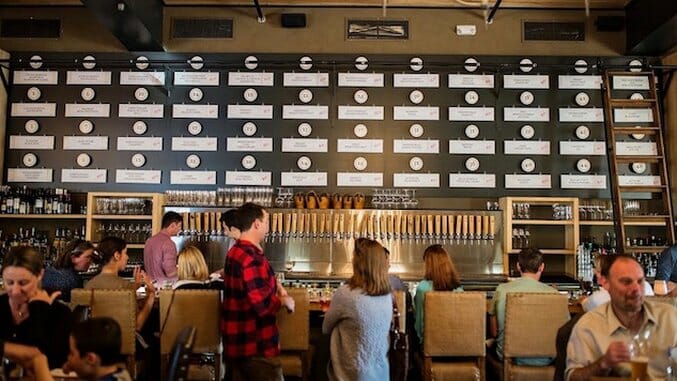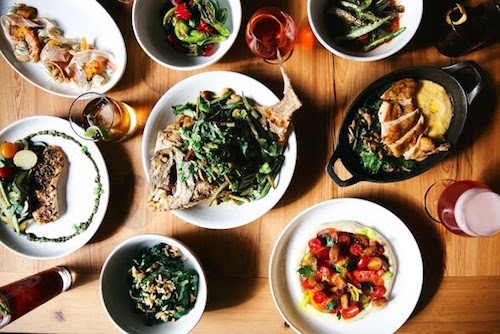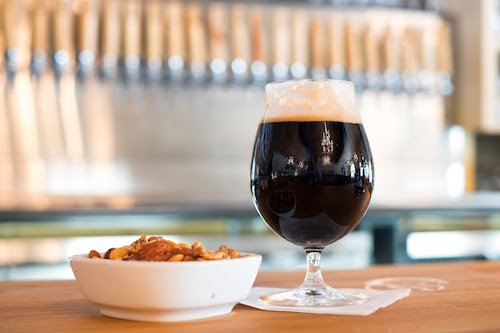
In Charleston, South Carolina, a town more and more lauded for its schizophrenically glorious approach to all things culinary, Edmund’s Oast stands above the fray. If you’re like me and think way too critically, way too much about things like this, the Oast is several juxtapositions wrapped up into one gastronomic microcosm: The restaurant is located on a fairly nondescript stretch of highway just outside downtown, yet it’s sleek and modern; It’s as big and open as a high school cafeteria, yet warm enough to invite intimacy; The food, drinks, and service on offer are all refined, yet carry a tinge of familiarity.
Here’s the nutshell version: opened just over two years ago by the same team behind the Charleston Beer Exchange (the area’s leading bottle shop and growler fill station), Edmund’s Oast is a fine(ish) dining establishment that focuses on highlighting seasonal ingredients indigenous to the region. They also cure their own meats, put their own meticulously crafted cocktails on draft, and—most relevantly, for our purposes—brew their own beer.
Even as recently as five years ago, a place like this simply would not have worked—not in Charleston, and not many other places. Head brewer and beer buyer Cameron Read is aware of that, and has some thoughts about what, culturally, allowed Edmund’s Oast to succeed.
“There are a couple of things at work,” says Read, literally 30 minutes before he has to go and train the front of house staff on new drink items. “Charleston is a huge food city; it seems like we have a great new restaurant opening up every month or so. And there’s a lot of consciously raised, consciously sourced food going on here. On the beer side of things, when the Charleston Beer Exchange opened, it really opened people’s eyes to what beer retail could look like. And now we’re trying to do a similar thing with the on-premise experience.”

Edmund’s Oast is certainly opening eyes, and opening them wide at that. Though every aspect of the restaurant—entrees, charcuterie, cocktails, service, etc.—is carefully curated and flawlessly executed, the house-brewed beers are a particularly huge talking point. See, Read and his team are not interested in your typical portfolio. Mostly.
“From the beginning, we knew we’d have 40-something taps, so we knew that not only would we be able to buy a lot of beers, but we’d have the room to play around. It freed us up to brew what we wanted to brew. Experimentation is one of the best things to me about brewing, and so the ‘normal’ stuff actually seems like a departure.”
And the “normal” stuff is damn good. Edmund’s Oast oatmeal stout and Vertex IIPA get consistently high marks from a notoriously fickle, Pokemon-minded craft beer community. But most of the house beers absolutely defy logic or categorization; when I was there, I enjoyed A Little Blue, a tart wheat ale aged in red wine barrels with blueberries, and Peanut Butter & Jelly, a brown ale that tastes exactly how you’d assume it does. Again, these are their house beers, and not even two of their wildest; A Little Blue is a constant re-brew, and PB&J is—even Read sounds bemused as he tells me this—their best-selling house-brewed beer. Other oddities like Australasia, a rare take on the Australian sparkling ale, and Even More Shneebus, an Against the Grain collaboration that is all at once tart, hoppy, and smoky, round out their list on any given day. And that’s not to mention the Farrago series, a constantly rotating range of blended happy-accident barrel projects…
“We have this small barrel room,” Read explains, “and barrels are finicky, so sometimes experiments don’t work out exactly how we thought it would. For example, we aged a beer recently in a cognac barrel, and it came out with way more oak and tannin character than we expected or wanted. But then when we blended it with another beer that just came out of a red wine barrel, the flavor profile worked.”
It’s an approach that’s remarkably similar to how lambic blenders approach their craft; each barrel will take on a different character over the course of time, and it is the blender’s job to get the most mileage out of each batch. In that way, Read and the skeleton brew-crew at Edmund’s Oast are, as in so many other ways, taking traditional methods and applying them to a modern context.
“This series is a way for us to blend all these beers that didn’t necessarily work out, but that equal something greater than the sum of their parts,” he says. “The name itself basically translated to ‘confused mixture.’” He adds, with a laugh, “It’s our Island of Misfit Toys.”

You could be forgiven for assuming that the approach of Read and crew is all-inclusive, hodgepodge, devil-may-care. And there is certainly an element of truth to that. Experimentation, as Read noted earlier, is the heart and soul of Edmund’s Oast. But it is also stridently beholden to the region that spawned it, and the menu is evidence of that: collard greens, Geechie Boy grits, and house-made cornbread—take it from this Georgia boy, some of the best in the Southeast—coexist alongside dishes like Chicken and Carolina Gold Rice Porridge with pickled shiitake and crab, pickled shrimp, and spicy lamb ragu with roasted spring onions. The minds behind Edmund’s Oast know it’s imperative to stand out while also being welcoming and accessible.
Read loves it. “On any given night,” he says, “you’ll see families sitting down to dinner together, businessmen still in their suits, guys in shorts and ball caps at the bar. Everyone comes here, and that’s the way we want it.”
Part of that across-the-spectrum success, of course, is owed to the impressively curated drink program. Along with the unique house beers, Edmund’s Oast features wine, mead, and cocktails, many of them also on draft. Delve deep into the guest beer list as well, and it’s not too hard to see where Read and his team get some of their inspiration: boutique importers like 12 Percent, Shelton Brothers, and B. United are well-represented. On my visit alone, there was a Zymatore series version of JW Lee’s Harvest Ale, Struise Cuvee Delphine, and Tilquin Geuze, all on draft, while the bottle list boasted a 2006 vintage of De Dolle Oerbier Special Reserva and a Jeroboam (3-litre) bottle of Evil Twin Bozo Beer. Feel like playing it a little safer, but don’t want to sacrifice quality? There’s also Weihenstephaner Hefe-Weissebier, Coast 32/50 Kolsch, and Bell’s Amber Ale.
“I feel a little schizophrenic sometimes,” Read, also the restaurant’s beer buyer, says. “I go out, put on my buyer’s hat, taste these beers ultra-critically, and then get right back into the brewery.”
Roles at Edmund’s Oast are, in some ways, strictly defined. But that doesn’t rule out the possibility—or, if we’re being honest, the very necessity—of constant feedback and collaboration among the staff. And while official sit-downs are rare, the various sectors of the restaurant are in constant dialogue.
“We have such a number of creative departments,” Read says. “For example, the head chef and his guys are very seasonally minded, and I’ve learned a lot about that through them. I might ask them what ingredients they have coming in, and that could inspire or influence the next batch of beer I brew. The bartender may introduce me to a new type of muscovado sugar he just got in. This is ongoing.”
As of this writing, the restaurant is still the only place you can get Edmund’s Oast beer, though that will be changing in the near future. There are plans to open up a 30-barrel production brewery off-site, where a bottling and canning line will also be set up. In addition, a store dubbed Edmund’s Oast Exchange will open adjacent to the restaurant, where customers will be able to purchase growlers to go, bottles, glassware, and more. It’s a move that has been in the works for a while, but Read, and everyone else involved, wants to make sure they dial everything in with regards to retail, including stability and shelf life.
“People have been asking us to package Peanut Butter & Jelly ever since we started brewing it,” he says with a laugh. “But trust me…right now, there are things we do to that beer that absolutely make it unstable for shelf life. We’re figuring it out, though.”